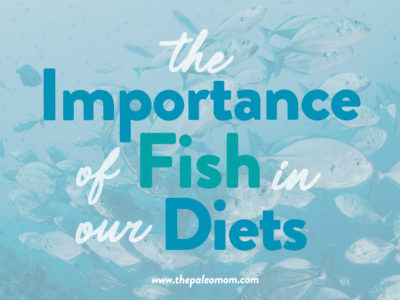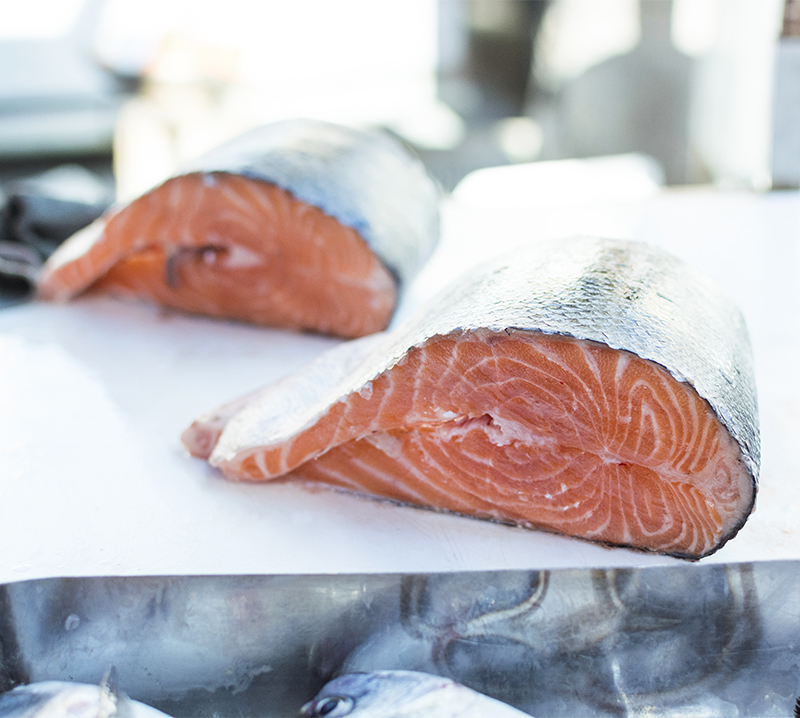 Of all the animal products, seafood has one of the most consistently positive track records in the scientific literature.
Of all the animal products, seafood has one of the most consistently positive track records in the scientific literature.
Oily cold-water fish like trout and salmon offer some amazing health benefits, including lowering risk of heart attack, hypertension, obesity, and diabetes. The omega-3 fats EPA and DHA, which are abundant in these types of fish, have been shown to reduce inflammation, lower blood pressure, protect against some cancers (including breast), increase insulin sensitivity, and improve endothelial function. The high selenium content of these fish can also help protect against some cancers, enhance bone health, maintain thyroid health, reduce the risk of infection, and assist in DNA production, and protect the body from free radical damage. Salmon and any fish with a similar salmon-pink or orange color also contain the antioxidant astaxanthin, which helps reduce LDL oxidation, boosts HDL levels, and protects against skin damage.
While whitefish might not get as much attention as omega-3-rich species, they still offer plenty of health benefits! In a meta-analysis of five prospective cohort studies, the high consumption of lean whitefish reduced the risk of stroke by 19% (which was even more than fatty fish intake, which reduced stroke risk by 12%). In Swedish women, three servings of lean fish per week reduced the risk of stroke by 33% compared to zero servings per week. And in Norwegian men, weekly lean fish consumption (including whitefish) was associated with lower risk of metabolic syndrome, lower triglyceride levels, and higher HDL cholesterol. A randomized crossover trial likewise found that simply adding 100 grams per day of whitefish (Namibia hake) to the diet significantly lowered waist circumference, diastolic blood pressure, and LDL levels! And, another trial found that eating 150 grams of cod per week caused significantly greater weight loss in young overweight adults, compared to a same-calorie diet without seafood.
 There have been a few European studies showing a U-shaped response curve to fish consumption, where moderate fish consumption reduces all-cause mortality and cardiovascular disease risk but higher fish consumption increases risk of all-cause mortality. The authors of these studies have postulated that this may be due to increased exposure to some of the toxins that can accumulate in fish, including methylmercury, dioxins, and polychlorinated biphenyls (PCBs), discussed in more detail below. However, this isn’t seen in studies of North American or Asian cohorts, where fish is equally as likely to contain these toxins. The authors of a rigorous 2017 meta-analysis proposed an alternate explanation for a U-shaped dose-response curve in Europe but a linear or curvilinear response curve elsewhere in the world: method of preparation. Traditional preparations of fish in many parts of Europe include deep-frying, pickling or salting, and it may be this high-salt and/or trans-fatty acid intake to blame for the higher all-cause mortality seen with higher fish consumption.
There have been a few European studies showing a U-shaped response curve to fish consumption, where moderate fish consumption reduces all-cause mortality and cardiovascular disease risk but higher fish consumption increases risk of all-cause mortality. The authors of these studies have postulated that this may be due to increased exposure to some of the toxins that can accumulate in fish, including methylmercury, dioxins, and polychlorinated biphenyls (PCBs), discussed in more detail below. However, this isn’t seen in studies of North American or Asian cohorts, where fish is equally as likely to contain these toxins. The authors of a rigorous 2017 meta-analysis proposed an alternate explanation for a U-shaped dose-response curve in Europe but a linear or curvilinear response curve elsewhere in the world: method of preparation. Traditional preparations of fish in many parts of Europe include deep-frying, pickling or salting, and it may be this high-salt and/or trans-fatty acid intake to blame for the higher all-cause mortality seen with higher fish consumption.
DHA and EPA: The Long-Chain Omega-3 Fats
 Fish and shellfish are also our dominant dietary sources of the long-chain omega-3 fatty acids DHA and EPA, which block multiple inflammation pathways in our cells. Deficiencies in these anti-inflammatory omega-3 fats have been linked to dyslexia, violence, depression, anxiety, memory problems, Alzheimer’s disease, weight gain, cancer, cardiovascular disease, stroke, eczema, allergies, asthma, inflammatory diseases, arthritis, diabetes, autoimmune diseases, and many others—so it’s easy to see why getting enough of them is important. In fact, omega-3s have been confirmed in study after study to reduce our risk of many chronic diseases and chronic disease risk factors, such as high triglycerides.
Fish and shellfish are also our dominant dietary sources of the long-chain omega-3 fatty acids DHA and EPA, which block multiple inflammation pathways in our cells. Deficiencies in these anti-inflammatory omega-3 fats have been linked to dyslexia, violence, depression, anxiety, memory problems, Alzheimer’s disease, weight gain, cancer, cardiovascular disease, stroke, eczema, allergies, asthma, inflammatory diseases, arthritis, diabetes, autoimmune diseases, and many others—so it’s easy to see why getting enough of them is important. In fact, omega-3s have been confirmed in study after study to reduce our risk of many chronic diseases and chronic disease risk factors, such as high triglycerides.
Studies evaluating the role of dietary omega-3 fatty acids in human health show that the ratio of dietary omega-3 to omega-6 fats is far more important than the actual quantities of these fats, provided that we are eating enough fat to meet our basic needs. An ideal ratio is somewhere between 1:1 and 1:4. However, typical Western diets fall into a range between 1:10 and 1:25! This is largely thanks to processed vegetable oils, grains, and the higher levels of omega-6 fatty acids that are present in the meat and dairy from grain-fed animals.
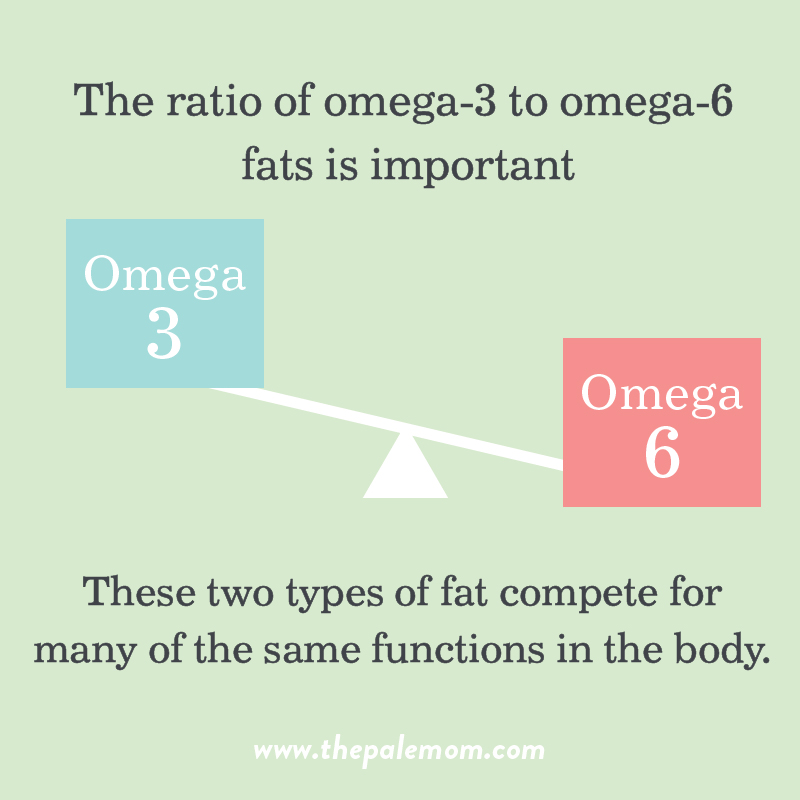 The ratio of omega-3 to omega-6 fats is important because these two types of fat compete for many of the same functions in the body. In particular, the omega-6 fatty acid arachidonic acid (AA) competes against the omega-3 fatty acids DHA and EPA. Depending on which type of fat “wins,” the effect is different. Within the outer membrane of every cell, various fatty acids and proteins are embedded, such as cholesterol molecules, receptors, and, yes, AA, DHA, and EPA. When incorporated into the membrane, DHA and EPA affect cell membrane properties, such as fluidity, flexibility, and permeability, and alter the activity of enzymes that are embedded in the membrane. These effects are beneficial to the health and function of the cell. And when needed, AA, DHA, and EPA can be internalized and metabolized into important signaling molecules (akin to short-distance hormones), called prostaglandins, thromboxanes, and leukotrienes, that control a variety of functions, including inflammation, clotting, vascular function and health, pain signaling, cell growth, kidney function, and stomach acid secretion.
The ratio of omega-3 to omega-6 fats is important because these two types of fat compete for many of the same functions in the body. In particular, the omega-6 fatty acid arachidonic acid (AA) competes against the omega-3 fatty acids DHA and EPA. Depending on which type of fat “wins,” the effect is different. Within the outer membrane of every cell, various fatty acids and proteins are embedded, such as cholesterol molecules, receptors, and, yes, AA, DHA, and EPA. When incorporated into the membrane, DHA and EPA affect cell membrane properties, such as fluidity, flexibility, and permeability, and alter the activity of enzymes that are embedded in the membrane. These effects are beneficial to the health and function of the cell. And when needed, AA, DHA, and EPA can be internalized and metabolized into important signaling molecules (akin to short-distance hormones), called prostaglandins, thromboxanes, and leukotrienes, that control a variety of functions, including inflammation, clotting, vascular function and health, pain signaling, cell growth, kidney function, and stomach acid secretion.
When diets contain predominantly omega-6 fatty acids, there is far more AA than DHA and EPA in the cell membranes. However, when diets are supplemented with omega-3 fatty acids, DHA and EPA can readily replace AA in the membranes of practically all cells. This is important because the prostaglandins, thromboxanes, and leukotrienes produced from AA are far more inflammatory and have other negative effects, like increasing pain, increasing thrombosis (clots forming in blood vessels, which can lead to things like deep vein thrombosis, stroke and ischemic heart disease), and constricting blood vessels, which increases blood pressure. This is why fish oil supplements have proven so effective at reducing cardiovascular disease risk factors and reducing pain from diseases like rheumatoid arthritis.
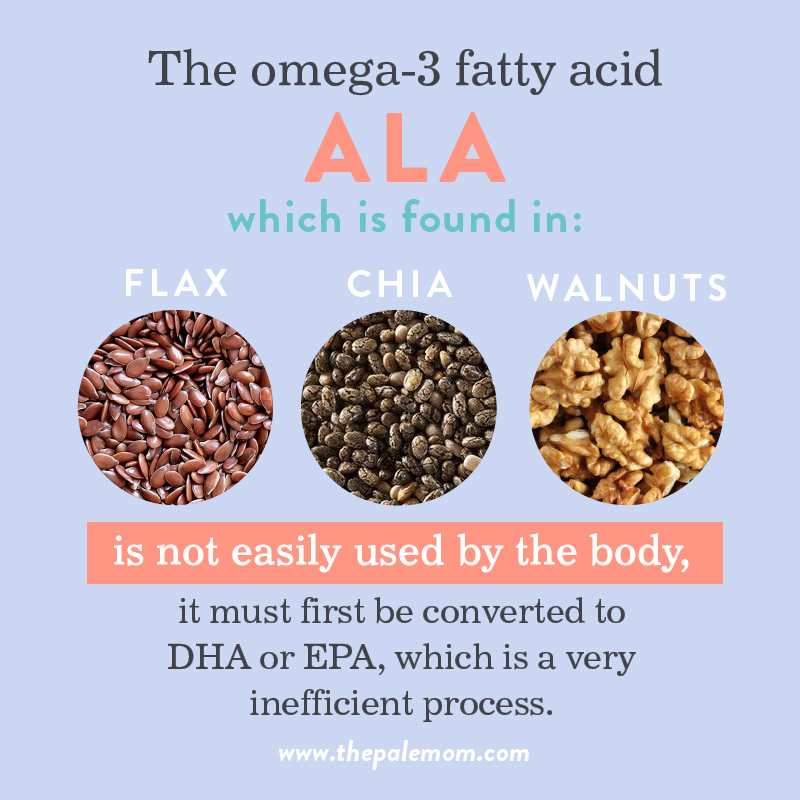 The omega-3s that our bodies really need are DHA and EPA. The shorter-chain omega-3 fatty acid ALA, which is found in flax seeds, chia seeds, and walnuts, is not easily used by the body because it must first be converted to DHA or EPA, which is a very inefficient process. A 3½-ounce serving of oily cold-water fish like wild-caught salmon, sardines, albacore tuna, trout, or mackerel has more than 500 milligrams of DHA and EPA. Fish containing moderate amounts of DHA and EPA (150 to 500 milligrams per 3½-ounce serving) include most whitefish like bass, cod, haddock, hake, halibut, flounder, perch, and sole, as well as farmed salmon. Crab, oysters, and shrimp contain moderate amounts of DHA and EPA as well, see TK.
The omega-3s that our bodies really need are DHA and EPA. The shorter-chain omega-3 fatty acid ALA, which is found in flax seeds, chia seeds, and walnuts, is not easily used by the body because it must first be converted to DHA or EPA, which is a very inefficient process. A 3½-ounce serving of oily cold-water fish like wild-caught salmon, sardines, albacore tuna, trout, or mackerel has more than 500 milligrams of DHA and EPA. Fish containing moderate amounts of DHA and EPA (150 to 500 milligrams per 3½-ounce serving) include most whitefish like bass, cod, haddock, hake, halibut, flounder, perch, and sole, as well as farmed salmon. Crab, oysters, and shrimp contain moderate amounts of DHA and EPA as well, see TK.
The omega-3 content of oily cold-water fish make them particularly beneficial for gut health. In fact, omega-3 fats are among the most gut-friendly fats around, and many of the benefits attributed to omega-3 fats on human health are mediated by the gut microbiome. See also What Is the Gut Microbiome? And Why Should We Care About It? and Why Fish is Great for the Gut Microbiome.
Animal studies have helped elucidate the omega-3, gut, and disease connection. In mice, analyses of gut microbiota and fecal transfers have shown that higher levels of omega-3 fats in body tissue are associated with greater production and secretion of intestinal alkaline phosphatase (an enzyme that splits cholesterol and long chain fatty acids). This leads to changes in the composition of gut bacteria that ultimately reduce endotoxin production, gut permeability, metabolic endotoxemia, and inflammation, all of which influence disease risk. Additional studies in mice have shown that omega-3-rich diets increase populations of important Lactobacillus and Bifidobacterium species.
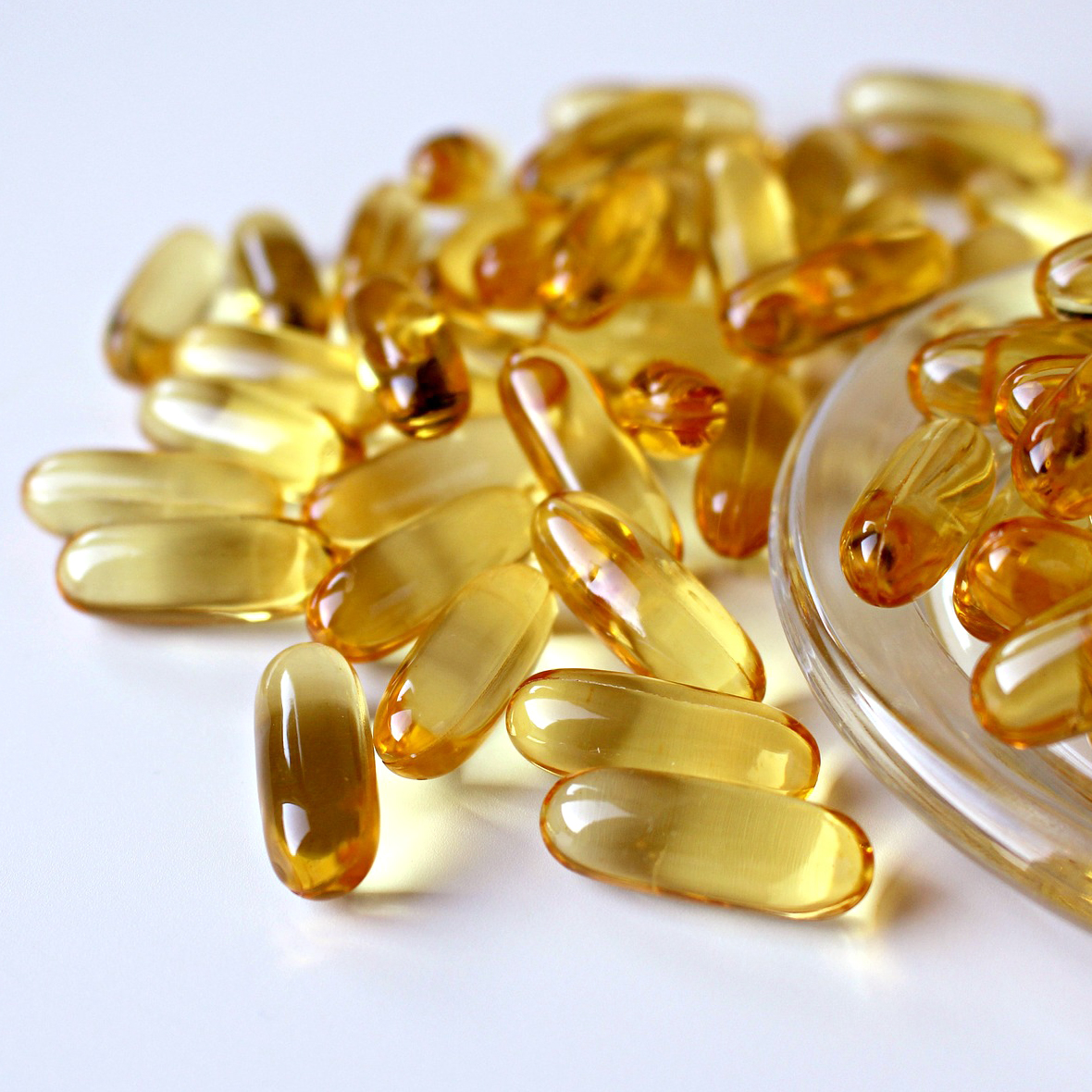 In humans, omega-3 supplementation leads to lower levels of Faecalibacterium and greater levels of butyrate-producing bacteria (particularly from the genera Eubacterium, Roseburia, Anaerostipes, and Coprococcus), along with higher levels of Bifidobacterium and Lactobacillus. Likewise, higher omega-3 levels (reflecting higher consumption) have been linked to more microbial diversity in the gut, as well as a greater abundance of short-chain fatty acid-producing bacteria belonging to the Lachnospiraceae family. Omega-3 fats also appear capable of reversing the dysbiosis associated with irritable bowel disease, and their anti-inflammatory effects can benefit other disorders involving inflammation of the gut.
In humans, omega-3 supplementation leads to lower levels of Faecalibacterium and greater levels of butyrate-producing bacteria (particularly from the genera Eubacterium, Roseburia, Anaerostipes, and Coprococcus), along with higher levels of Bifidobacterium and Lactobacillus. Likewise, higher omega-3 levels (reflecting higher consumption) have been linked to more microbial diversity in the gut, as well as a greater abundance of short-chain fatty acid-producing bacteria belonging to the Lachnospiraceae family. Omega-3 fats also appear capable of reversing the dysbiosis associated with irritable bowel disease, and their anti-inflammatory effects can benefit other disorders involving inflammation of the gut.
Nutrivore Weekly Serving Matrix
An easy-to-use and flexible weekly checklist
to help you maximize nutrient-density.
The Weekly Serving Matrix is very helpful! I’ve been eating along these lines but this really helps me know where to focus vs. which foods serve a more secondary role. It’s super helpful and has taken a lot of worry out of my meal planning. Thanks!
Jan
Omega-3 intake during pregnancy could even influence the offspring’s risk of obesity through gut-mediated mechanisms. One study using fat-1 transgenic mice (which produce high levels of endogenous omega-3 fats) and wild-type mice found that a lower ratio of omega-3 to omega-6 fatty acids in a mother’s body during pregnancy and breastfeeding altered the balance of gut microbiota in her offspring, induced indicators of metabolic disruption, and led to significantly more weight gain. Another study using fat-1 mice found that higher levels of tissue omega-3 helped prevent gut dysbiosis induced by early exposure to antibiotics and protected against obesity, insulin resistance, fatty liver, and dyslipidemia later in life.
Why not just get DHA and EPA from fish oil supplements? These polyunsaturated fats are easily oxidized in response to heat or light and are not very shelf-stable, especially once isolated. Consuming oxidized omega-3 fats contributes to inflammation as opposed to reducing it. In fresh, frozen, or canned whole fish, the omega-3 fats are protected from oxidation, plus fish provides all the necessary cofactors for optimal absorption and use by the body. Learn more in TWV Podcast Episode 415: Fish oil, Healthy or not?.
Fish Protein
Along with omega-3s, fish is high in protein, and research shows that the amino acids in fish are more bioavailable (that is, our bodies can absorb and use them more readily) than those in beef, pork, or chicken. Fish also has balanced quantities of all the essential amino acids, giving the various types of fish high amino acid scores (a measure of protein quality).
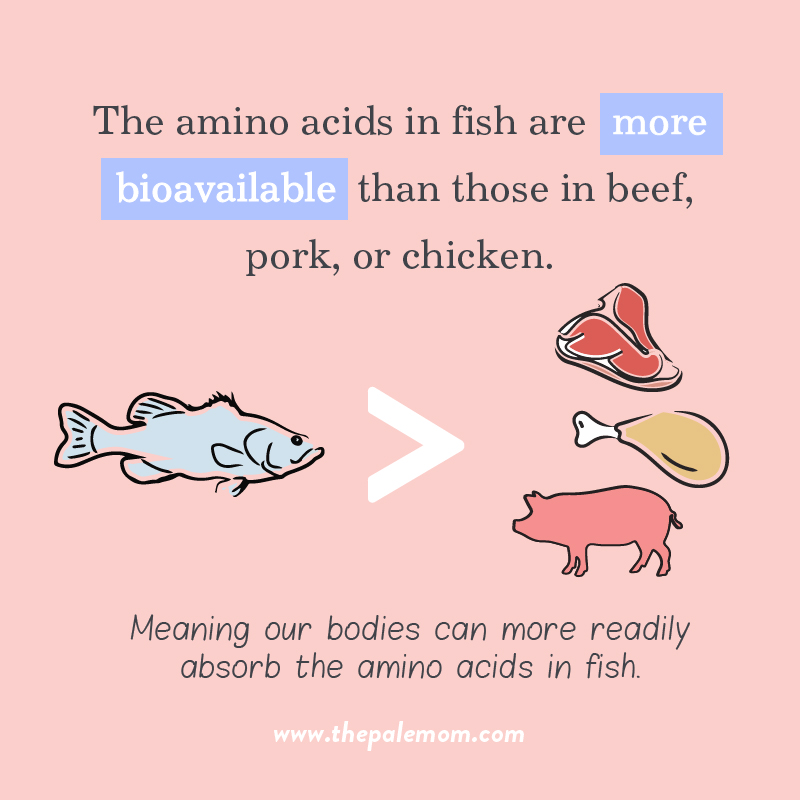 A number of methods have been used to assess protein quality, but the newest and most comprehensive one (promoted by the Food and Agriculture Organization of the United Nations) is the Digestible Indispensable Amino Acid Score (DIAAS). This method measures the digestibility of individual amino acids by analyzing fecal matter at the end of the small intestine (in contrast to the previous protein ranking standard, the Protein Digestibility Corrected Amino Acid Score [PDCAAS], which measures absorption throughout the digestive system and doesn’t take into account protein absorption by gut bacteria). The DIAAS score is calculated based on individual amino acid digestibility, the original amino acid content of the food, and human amino acid requirements. The higher the score, the higher the protein quality, but generally anything higher than 1 is awesome. While DIAAS scores have been calculated for only a limited number of foods so far, the DIASS for pangas is 1.06 and tilapia is 1.00.
A number of methods have been used to assess protein quality, but the newest and most comprehensive one (promoted by the Food and Agriculture Organization of the United Nations) is the Digestible Indispensable Amino Acid Score (DIAAS). This method measures the digestibility of individual amino acids by analyzing fecal matter at the end of the small intestine (in contrast to the previous protein ranking standard, the Protein Digestibility Corrected Amino Acid Score [PDCAAS], which measures absorption throughout the digestive system and doesn’t take into account protein absorption by gut bacteria). The DIAAS score is calculated based on individual amino acid digestibility, the original amino acid content of the food, and human amino acid requirements. The higher the score, the higher the protein quality, but generally anything higher than 1 is awesome. While DIAAS scores have been calculated for only a limited number of foods so far, the DIASS for pangas is 1.06 and tilapia is 1.00.
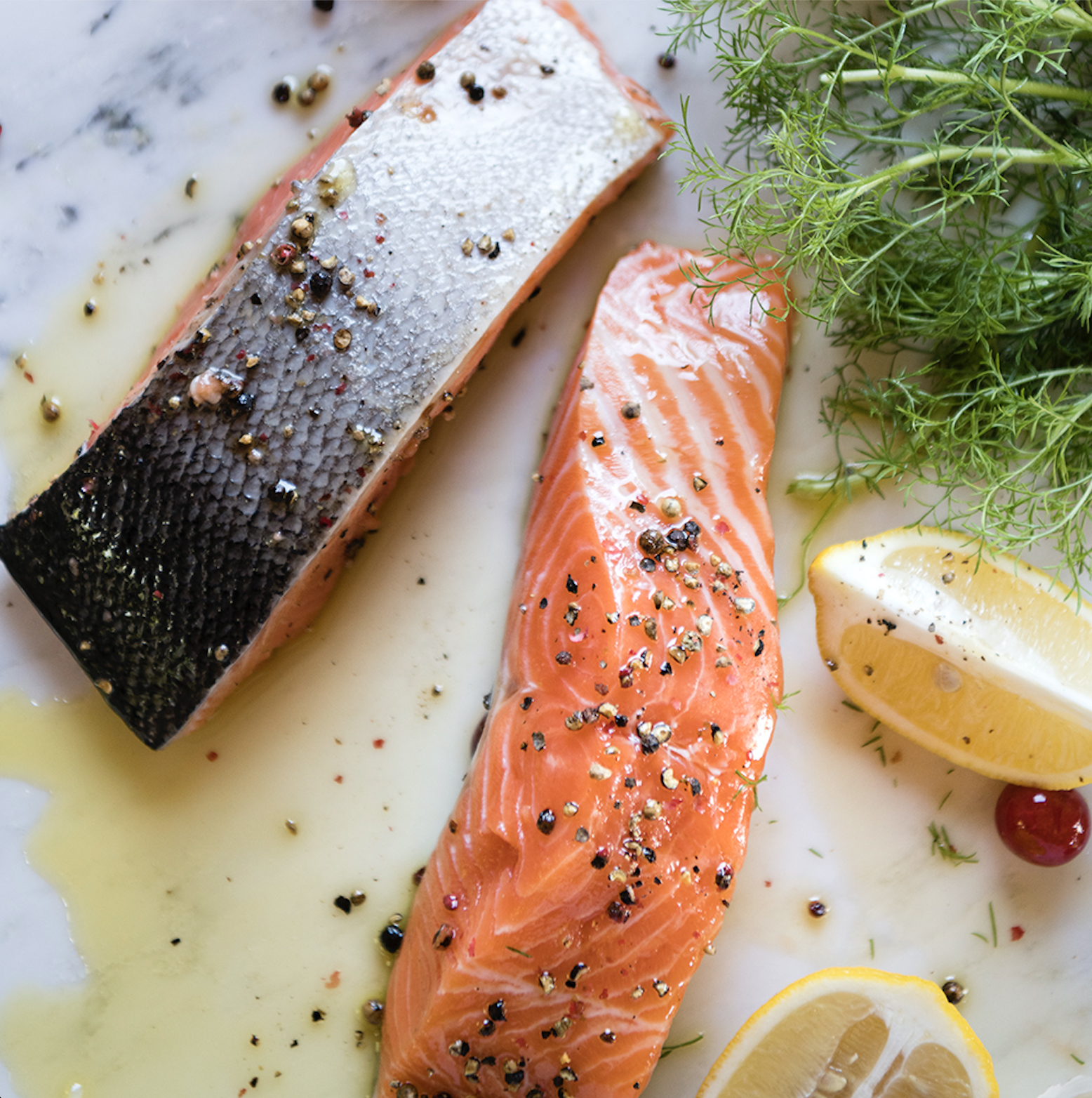 Fish protein has also specifically been linked to improvements in inflammation, metabolic syndrome, osteoporosis, insulin resistance, obesity-related comorbidity and cancer risk. This may be mediated through the gut microbiome. In one rat study comparing fishmeal with soy protein and casein, fish protein led to high levels of butyric acid. In mice, 12 weeks of a diet containing protein from lean seafood (ling, rosefish, cod, wolf fish, and muscle from Canadian scallop) compared to a diet containing a mixture of skinless chicken breast, pork tenderloin, and beef sirloin found that not only was the seafood diet less obesogenic, it also led to higher levels of Bacteroidales and Clostridiales, with the seafood diet leading to greater expression of genes involved in metabolism of aromatic amino acids. Another study comparing protein from fish, chicken, casein, soy, pork, and beef found that the fish protein (along with chicken protein) led to a greater abundance of lactobacilli, higher levels of Firmicutes, and lower levels of Bacteroidetes than the other proteins. See also What Is the Gut Microbiome? And Why Should We Care About It? and Why Fish is Great for the Gut Microbiome.
Fish protein has also specifically been linked to improvements in inflammation, metabolic syndrome, osteoporosis, insulin resistance, obesity-related comorbidity and cancer risk. This may be mediated through the gut microbiome. In one rat study comparing fishmeal with soy protein and casein, fish protein led to high levels of butyric acid. In mice, 12 weeks of a diet containing protein from lean seafood (ling, rosefish, cod, wolf fish, and muscle from Canadian scallop) compared to a diet containing a mixture of skinless chicken breast, pork tenderloin, and beef sirloin found that not only was the seafood diet less obesogenic, it also led to higher levels of Bacteroidales and Clostridiales, with the seafood diet leading to greater expression of genes involved in metabolism of aromatic amino acids. Another study comparing protein from fish, chicken, casein, soy, pork, and beef found that the fish protein (along with chicken protein) led to a greater abundance of lactobacilli, higher levels of Firmicutes, and lower levels of Bacteroidetes than the other proteins. See also What Is the Gut Microbiome? And Why Should We Care About It? and Why Fish is Great for the Gut Microbiome.
Vitamins and Minerals in Fish
Fish are not only nutrient-dense sources of highly-digestible complete protein, but they’re outstanding sources of important nutrients in which we are commonly deficient. See also Essential Nutrient Deficiency and Autoimmune Disease and 7 Nutrients You’re Probably Deficient In
Fish is a great source of vitamins B1, B2, B3, B6, B9, B12 and E, zinc, phosphorus, magnesium, iron, copper, potassium and selenium, with oily cold-water fish also providing substantial amounts of vitamin A and vitamin D. Fish with bones remaining, such as canned salmon and sardines, are the best dietary sources of calcium in the food supply. And marine fish are an excellent dietary source of iodine.
 Fish in general is a particularly important source of two minerals that can be challenging to get in sufficient quantities from other foods: iodine and selenium.
Fish in general is a particularly important source of two minerals that can be challenging to get in sufficient quantities from other foods: iodine and selenium.
Iodine (which is also rich in algae and seaweed) is vital for normal thyroid function but also extremely important for proper immune system function, wound healing, and fertility. Table salt is enriched with iodine due to rampant dietary iodine deficiency in the past (goiters were common before the advent of iodized salt). Since Paleo diets tend to be lower in salt—and many people switch to sea salt, which is not iodized—it is critical to consume food sources of this essential mineral.
Selenium is required for a class of enzymes called selenoenzymes, which are part of the body’s natural protection against oxidants. Selenoenzymes are particularly important for protecting the brain against oxidative damage, but selenium deficiencies are also linked to thyroid disease, cardiovascular disease, and cancer.
Fish is also the best food source of vitamin D, which can also be found in organ meat but is generally hard to obtain from diet alone. People living far from the equator and/or in overcast climates may be particularly susceptible to vitamin D deficiency and incapable of obtaining enough of it through sun exposure, making dietary sources more important. Another way in which fish is an invaluable inclusion in our diet.
For example, half a filet of wild Atlantic salmon contains 281 calories, 40 grams of protein, 4 grams of omega-3 fatty acids, over 100% of the DV for selenium and vitamin B12, about 80% of the DV for vitamin B6 and Niacin, 44% of the DV for riboflavin, 33% of the DV for pantothenic acid, 30% of the DV for thiamin, a quarter of the DV for potassium and copper, and also some folate, iron, and zinc. One filet of wild trout contains 189 calories, 1.3 milligrams of omega-3 fats, 32 grams of protein, over 100% of the DV for vitamin B12, 43% of the DV for niacin and phosphorus, 32% of the DV for vitamin B6, 29% of the DV for selenium, and some thiamin, riboflavin, folate, pantothenic acid, zinc, calcium, copper, and manganese. And cod contains 189 calories per filet (180 grams of cooked fish), along with 97% of the DV for selenium, 32% of the DV for vitamin B12, 25% of the DV for vitamin B6 and phosphorus, 23% of the DV for niacin, 19% of the DV for magnesium, 13% of the DV for potassium, 11% of the DV for thiamin, and smaller amounts of vitamin E, riboflavin, folate, pantothenic acid, calcium, iron, zinc, copper, and manganese.
Mercury, Dioxins, PCBs and Radiation
We are often warned not to consume too much seafood due to the fear of mercury contamination in these foods building up in our systems and leading to mercury poisoning. Pregnant women are advised to limit seafood consumption to a measly two 6-ounce servings per week, the thinking being that mercury could cause brain damage in the developing fetus. It certainly sounds scary, but is this concern well founded?
 Seafood that tends to contain very low levels of methylmercury include shellfish (including oysters, clams, scallops, mussels, crab, shrimp, lobster), salmon, trout, herring, haddock, pollock (Boston bluefish), sole, flounder, Atlantic mackerel, and lake whitefish. However, any fish that contains more selenium than methylmercury is perfectly safe to consume because the selenium binds irreversibly with the mercury to prevent its harmful effects in our bodies. In fact, the selenium in seafood can help protect us from mercury exposure from other sources. The only exceptions are those top-predator fish from contaminated waters in which the methylmercury accumulation is higher than their selenium content, which is a fairly short list: king mackerel, marlin, pilot whale, shark, tarpin, tilefish, and swordfish, although some studies show that swordfish is okay. See The Mercury Content of Seafood: Should we worry?
Seafood that tends to contain very low levels of methylmercury include shellfish (including oysters, clams, scallops, mussels, crab, shrimp, lobster), salmon, trout, herring, haddock, pollock (Boston bluefish), sole, flounder, Atlantic mackerel, and lake whitefish. However, any fish that contains more selenium than methylmercury is perfectly safe to consume because the selenium binds irreversibly with the mercury to prevent its harmful effects in our bodies. In fact, the selenium in seafood can help protect us from mercury exposure from other sources. The only exceptions are those top-predator fish from contaminated waters in which the methylmercury accumulation is higher than their selenium content, which is a fairly short list: king mackerel, marlin, pilot whale, shark, tarpin, tilefish, and swordfish, although some studies show that swordfish is okay. See The Mercury Content of Seafood: Should we worry?
As for dioxins and PCBs, which are of concern due to their carcinogenic properties, fish is actually much lower in these pollutants than other foods (including beef, chicken, pork, dairy products, and vegetables).
The levels of radioactive isotopes found in Pacific fish (outside of the coastal waters within 20 km of Fukushima itself) are so low that we would need to eat 700,000 pounds just to match the amount of radiation we normally get each year from other sources (like cosmic rays from the sun). Even eating those contaminated fish caught within the coastal waters near Fukushima would add up to an effective dose of about 0.6% of the 100 millisievert per year dose linked to increased cancer risk. See Should We Be Worried About Radiation from Fukushima?
 In fact, human studies show that the more seafood we consume the better, which would not be the case if the toxins in fish were a substantial concern. A 2017 meta-analysis showed that, compared with little or no intake, modest fish consumption (40 grams, or about 1.5 ounces, per day) results in a 9% decrease in all-cause mortality, a general measurement of health and longevity. This benefit was largely (but not entirely) attributable to DHA and EPA intake, which when analyzed separately, revealed a 7% lower risk of all-cause mortality for every 0.2 grams per day increase in dietary intake! Another 2017 analysis showed a nearly linear relationship between increased fish consumption and reduced all-cause mortality, indicating the more the better!
In fact, human studies show that the more seafood we consume the better, which would not be the case if the toxins in fish were a substantial concern. A 2017 meta-analysis showed that, compared with little or no intake, modest fish consumption (40 grams, or about 1.5 ounces, per day) results in a 9% decrease in all-cause mortality, a general measurement of health and longevity. This benefit was largely (but not entirely) attributable to DHA and EPA intake, which when analyzed separately, revealed a 7% lower risk of all-cause mortality for every 0.2 grams per day increase in dietary intake! Another 2017 analysis showed a nearly linear relationship between increased fish consumption and reduced all-cause mortality, indicating the more the better!
Which Fish Are Best?
Oily coldwater, wild-caught fish have the most omega-3 fatty acids and vitamin D. However, even freshwater whitefish are an excellent source of protein and omega-3s. The fish with the least favorable omega-3 to omega-6 ratio are farmed tilapia and farmed catfish, which have about a 1:1 ratio, as compared to a 300:1 ratio in salmon, but they still have that easily digested protein, vitamins and minerals. And while fresh and frozen fish can be expensive, sardines, canned salmon, and other canned fish are great affordable options. Pickled herring and smoked kippers are often less expensive as well.
How much fish should we eat? Three to five 6-ounce servings of oily cold-water fish per week (on top of other varieties of fish and shellfish) will provide us with the recommended intake of DHA and EPA. Fish is an excellent nutrient-dense protein food, and the science shows we’re
Citations
Abdelhamid AS, Brown TJ, Brainard JS, Biswas P, Thorpe GC, Moore HJ, Deane KH, AlAbdulghafoor FK, Summerbell CD, Worthington HV, Song F, Hooper L. Omega-3 fatty acids for the primary and secondary prevention of cardiovascular disease. Cochrane Database Syst Rev. 2018 Jul 18;7(7):CD003177. doi: 10.1002/14651858.CD003177.pub3.
Abdelhamid AS, Brown TJ, Brainard JS, Biswas P, Thorpe GC, Moore HJ, Deane KH, AlAbdulghafoor FK, Summerbell CD, Worthington HV, Song F, Hooper L. Cochrane Database Syst Rev. Omega-3 fatty acids for the primary and secondary prevention of cardiovascular disease. 2018 Nov 30;11(11):CD003177. doi: 10.1002/14651858.CD003177.pub4.
Costantini, L., R. Molinari, B. Farinon, and N. Merendino. 2017. “Impact of Omega-3 Fatty Acids on the Gut Microbiota.” International Journal of Molecular Sciences. 18(12):2645. doi:10.3390/ijms18122645.
Fabian, C.J., B.F. Kimler, and S.D. Hursting. 2015. “Omega-3 fatty acids for breast cancer prevention and survivorship.” Breast Cancer Research. 17(1):62. doi:10.1186/s13058-015-0571-6.
Jayedi A, Shab-Bidar S, Eimeri S, Djafarian K. Fish consumption and risk of all-cause and cardiovascular mortality: a dose-response meta-analysis of prospective observational studies. Public Health Nutr. 2018 May;21(7):1297-1306. doi: 10.1017/S1368980017003834.
Kaliannan, K., B. Wang, X. Li, et al. 2015. “A host-microbiome interaction mediates the opposing effects of omega-6 and omega-3 fatty acids on metabolic endotoxemia.” Scientific Reports 5(11276). doi:10.1038/srep11276.
Kaliannan, K., B. Wang, X. Li, et al. 2016. “Omega-3 fatty acids prevent early-life antibiotic exposure-induced gut microbiota dysbiosis and later-life obesity.” International Journal of Obesity. 40:1039–1042. doi:10.1038/ijo.2016.27.
Kwok CS, Gulati M, Michos ED, Potts J, Wu P, Watson L, Loke YK, Mallen C, Mamas MA. Dietary components and risk of cardiovascular disease and all-cause mortality: a review of evidence from meta-analyses. Eur J Prev Cardiol. 2019 Sep;26(13):1415-1429. doi: 10.1177/2047487319843667.
Larsson, S.C., J. Virtamo, and A. Wolk. 2011. “Fish consumption and risk of stroke in Swedish women.” American Journal of Clinical Nutrition. 93(3):487–493. doi:10.3945/ajcn.110.002287.
Menni, C., J. Zierer, T. Pallister, et al. 2017. “Omega-3 fatty acids correlate with gut microbiome diversity and production of N-carbamylglutamate in middle aged and elderly women.” Scientific Reports. 7(11079). doi:10.1038/s41598-017-10382-2.
Minihane, A.M., C.K. Armah, E.A. Miles, et al. 2016. “Consumption of Fish Oil Providing Amounts of Eicosapentaenoic Acid and Docosahexaenoic Acid That Can Be Obtained from the Diet Reduces Blood Pressure in Adults with Systolic Hypertension: A Retrospective Analysis.” Journal of Nutrition. 146(3):516-523. doi:10.3945/jn.115.220475.
Qin, Z., J. Xu, G. Chen, et al. 2018. “Effects of fatty and lean fish intake on stroke risk: a meta-analysis of prospective cohort studies.” Lipids in Health and Diseases. 17(264). doi:10.1186/s12944-018-0897-z.
Ramel, A., M.T Jonsdottir, and I. Thorsdottir. 2009. “Consumption of cod and weight loss in young overweight and obese adults on an energy reduced diet for 8-weeks.” Nutrition, Metabolism & Cardiovascular Diseases. 19(10):690-696. doi:10.1016/j.numecd.2008.12.013.
Robertson, R.C., K. Kaliannan, C.R. Strain, R.P. Ross, C. Stanton, J.X. Kang. 2018. “Maternal omega-3 fatty acids regulate offspring obesity through persistent modulation of gut microbiota.” Microbiome. 6(1). doi:10.1186/s40168-018-0476-6.
Sarvenaz Khalili Tilami & Sabine Sampels (2018) Nutritional Value of Fish: Lipids, Proteins, Vitamins, and Minerals, Reviews in Fisheries Science & Aquaculture. 2018. 26(2): 243-253, DOI: 10.1080/23308249.2017.1399104
Schwingshackl L, Schwedhelm C, Hoffmann G, Lampousi AM, Knüppel S, Iqbal K, Bechthold A, Schlesinger S, Boeing H. Food groups and risk of all-cause mortality: a systematic review and meta-analysis of prospective studies. Am J Clin Nutr. 2017 Jun;105(6):1462-1473. doi: 10.3945/ajcn.117.153148.
Shaheen N, Islam S, Munmun S, Mohiduzzaman M, Longvah T. Amino acid profiles and digestible indispensable amino acid scores of proteins from the prioritized key foods in Bangladesh. Food Chem. 2016 Dec 15;213:83-89. doi: 10.1016/j.foodchem.2016.06.057.
Tørris, C., M. Molin, and M.S. Cvancarova. 2016. “Lean fish consumption is associated with lower risk of metabolic syndrome: a Norwegian cross sectional study.” BMC Public Health. 16(347). doi:10.1186/s12889-016-3014-0.
Vázquez, C., J.I. Botella-Carretero, D. Corella, et al. 2014. “White fish reduces cardiovascular risk factors in patients with metabolic syndrome: the WISH-CARE study, a multicenter randomized clinical trial.” Nutrition, Metabolism and Cardiovascular Diseases. 24(3):328-335. doi:10.1016/j.numecd.2013.09.018.
Wan Y, Zheng J, Wang F, Li D. Fish, long chain omega-3 polyunsaturated fatty acids consumption, and risk of all-cause mortality: a systematic review and dose-response meta-analysis from 23 independent prospective cohort studies. Asia Pac J Clin Nutr. 2017;26(5):939-956. doi: 10.6133/apjcn.072017.01. http://apjcn.nhri.org.tw/server/APJCN/26/5/939.pdf
Yoon, H.S., H.H. Cho, S. Cho, S.R. Lee, M.H. Shin, and J.H. Chung. 2014. “Supplementating with dietary astaxanthin combined with collagen hydrolysate improves facial elasticity and decreases matrix metalloproteinase-1 and -12 expression: a comparative study with placebo.” Journal of Medicinal Food. 17(7):810-816. doi:10.1089/jmf.2013.3060.
Zhao LG, Sun JW, Yang Y, Ma X, Wang YY, Xiang YB. Fish consumption and all-cause mortality: a meta-analysis of cohort studies. Eur J Clin Nutr. 2016 Feb;70(2):155-61. doi: 10.1038/ejcn.2015.72.
Zivkovic, A.M., N. Telis, J.B. German, and B.D. Hammock. 2011. “Dietary omega-3 fatty acids aid in the modulation of inflammation and metabolic health.” California Agriculture. 65(3):106-111. doi:10.3733/ca.v065n03p106.

